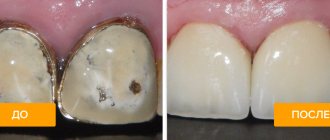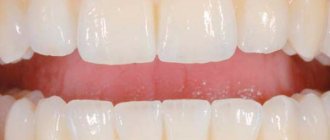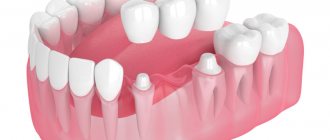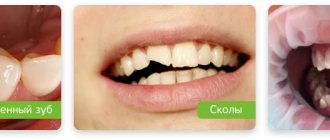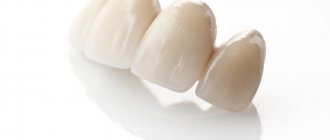Fixed prosthetics is a popular method of restoring the appearance and chewing-aesthetic function of the dentition. Reconstruction of damaged teeth with artificial prostheses covering only the supragingival part of the tooth is performed with metal, metal-ceramic, all-ceramic, metal-plastic and other crowns. Metal-ceramics are most in demand because... in terms of external data and technical characteristics, it is not much inferior to metal-free ceramics.
A metal-ceramic prosthesis consists of a frame based on a cobalt-chromium alloy, titanium, galvanic gold, platinum or palladium, coated on top with a ceramic mass. Based on the quality of ceramics, crowns are divided into standard and highly artistic.
Differences from metal and all-ceramic
A metal-ceramic (MC) crown is the best option for covering the destroyed coronal part of a tooth, because with its help, size, shape, color and chewing function are restored. However, the tooth must first be treated with endodontic methods.
All-ceramic products are distinguished by their artistry, less thickness because they lack a metal frame, but also greater fragility. In this regard, metal-free crowns are placed mainly on the frontal areas, although they are also allowed on premolars, because they don't have to bear a lot of stress when chewing. In addition to ceramics, porcelain crowns based on zirconium dioxide are used in their pure form. This is a white translucent metal that serves as a substrate for applying ceramic mass. The small thickness of the prosthesis allows the use of a minimally aggressive technique for preparing vital teeth.
Metal crowns are made by casting or stamping from gold, silver-palladium compounds, cobalt-chromium and nickel-chromium alloys. These thin-walled copings are designed to strengthen the coronal portion. Their appearance is unpretentious, so they cover only the chewing group of teeth. Prostheses made of base metals are available without sputtering (“silver-like”) and with sputtering (“gold-like”). Products made from electroplated gold are convenient in cases where the patient has a history of allergies to metals.
Operation
Medium difficulty
There are contraindications
Doctor's qualifications
High
Bridge or implant: what to choose
Some people are not happy with the way a bridge looks on their teeth (photo below). Others fear that during sharpening, most of the healthy tissue will be damaged, and the supporting elements will simply fall off. There are other negative aspects that doctors pay attention to:
- pressure is unevenly distributed on the chewing surface in the oral cavity;
- the enamel suffers because its integrity is compromised;
- the product has a short service life.
Even if metal ceramics were installed, in no more than 10 years it will become unusable. This is one of the factors that can influence the choice of implants, which guarantees the preservation of an attractive smile for decades. However, it is up to the attending physician to decide what is preferable to mount.
The patient expresses his wishes regarding the appearance and final cost. Before making a decision, it is important to compare all the advantages and disadvantages, and then settle on one or another design, depending on your financial capabilities.
Successful combination
It also happens that the best solution is to use a complex model that combines the simultaneous installation of one of the types of dental bridges on the teeth to restore lost units and implantation of an implant. This happens in situations with complete edentia, that is, when the mouth is completely empty, and there is nothing to attach the bridge structure to.
In this case, artificial elements are mounted as a support, and the prosthesis is fixed between them. This is the best option for patients who would never agree to wear dentures.
Metal-ceramic crowns - photo
The photo shows the following types of metal-ceramic crowns:
- For side sections;
- Frontal crown;
- On a frame made of irradiated gold;
- MK with pin;
- Telescopic;
- Half-crown.
Photo of dental crowns
How often do you visit the dentist?
Advantages of metal-ceramic crowns
There are many advantages of metal-ceramic dentures:
- The color, shape, size, transparency and strength of the artificial prosthesis are identical to the patient’s own teeth;
- Strengthening and reinforcing the crown part gives the tooth a “second” life for many years;
- Metal ceramics do not change color and soft and hard deposits do not accumulate on it;
- The degree of abrasion of ceramics is close to that of enamel;
- Due to the exact correspondence of the shape and size of the metal frame to the contours of the stump, the crowns “sit” firmly and do not allow microorganisms to pass under them;
- The metal base gives the crown increased strength, so “protected” teeth can withstand high mechanical loads;
Cost of the operation
from 20,000 rub.
Recovery time
from 3 days
Operation time
from 60 to 180 minutes
How is teeth color determined?
Dentists define it according to one principle. There is a Vita scale that divides varieties according to shade range:
- brown;
- grey;
- yellow;
- red.
There is no white: it is an unnatural phenomenon created by technology.
The degrees of shades are divided into 4 ordinal levels. O is not on the table. The Latin letter "A" is red-brown. The higher the number in the index, the darker the enamel:
- light teeth - “A1”;
- darker - “A2”;
- even darker - “A3”;
- very dark - “A4”.
Yellow - Latin "B". There is a gradation from 1 to 4. The gray shade is characterized by the indices “C1”, “C2” and further down the list. The red-gray surface on the Vita scale is designated by the Latin letter “D”.
Flaws
The disadvantages of metal-ceramics are mainly due to the thickness of the prosthesis. The metal frame and ceramic layer force the dentist to sharply grind the tooth. Therefore, dental units subject to prosthetics are first subjected to endodontic treatment. This is undesirable for a healthy tooth, since depulpation makes it more fragile.
Dental prosthetics with products is not recommended for children under 16 years of age due to the thin enamel-dentin layer and the close proximity of the horns of the pulp chamber, which means depulpation will inevitably be required.
The ceramic mass completely covers the metal base, with the exception of a small gap on the lingual side. The open metal part (“garland”) can cause discomfort in the oral cavity, and in cases where the patient already has other metal dentures, galvanization phenomena are possible.
In the frontal area, products made from MC may not look very natural, so here it is advisable to do prosthetics with all-ceramic crowns.
When is a prosthesis needed?
Loss of teeth is not only an aesthetic problem. The absence of one or more elements in a row leads to negative consequences:
- The functioning of the digestive system is disrupted. This is due to the fact that products that are not crushed enough when chewed enter the gastrointestinal tract.
- Atrophic processes in bone tissue, external deformation of the maxillofacial apparatus. Due to the lack of incisors, canines or molars over a long period of time, the jaws do not receive sufficient load, and their functions are gradually lost.
- Change in bite. Healthy units fill the empty space, moving to the sides. Wide interdental spaces are formed.
To prevent the complications listed above, it is recommended not to delay prosthetics and visit a doctor as soon as possible. An experienced physician is able to assess the true extent of the problem. He will select the appropriate option, which will help in a particular case.
Types of metal-ceramic crowns
The main task of a MC prosthesis is to protect and strengthen the heavily damaged crown part of the tooth. Such crowns completely envelop the tooth on all sides.
There are crowns with a pin that serve both to restore the integrity of the tooth and to strengthen it. They are used for very badly damaged coronal parts. The pin is cemented into one of the roots of the tooth.
A half-crown is a prosthesis covered with ceramic mass only on the oral and chewing sides (or on the cutting edge side), as well as on the sides in contact with neighboring teeth. The lingual side of the prosthesis remains uncovered. Typically, such measures are resorted to to reduce the cost of the crown.
Telescopic crowns have an internal built-in lock designed for fixation to the stump inlay on the abutment tooth of a removable denture.
Based on the manufacturing method, a distinction is made between MC prostheses that have undergone sintering or those made by computer modeling and milling.
Indications for installation
Basically, metal-ceramic prostheses are placed in the following cases:
- destruction or traumatic fracture of at least 2/3 of the crown part of the front or chewing teeth;
- extensive fillings that spoil the aesthetics or do not adhere well to the teeth;
- anomalies in the shape, size, color or position of individual dental units that cannot be corrected by other dental methods;
- pathological abrasion of enamel;
- non-carious lesions of enamel, fluorosis;
- age-related changes in the shape, color, shine of individual teeth or disruption of their aesthetics after previous dental treatment;
- allergic reactions to crowns made of other materials;
- moderately loose teeth. In this case, prostheses are used for splinting, but they are not put on individual units, but in the form of a small metal-ceramic bridge;
- preparing an abutment tooth for attaching a clasp to attachments or a denture to telescopic crowns.
Conditionally removable prosthetics
As mentioned above, doctors in many dentistry places only permanent bridges on teeth, which means that it is technically impossible to get the structure if desired. However, there is another option for mounting the installation. This is the same prosthesis, only with a single intermediate part. Instead of crowns, fasteners-locks are mounted.
The solution is suitable for both artificial and natural units preserved in the oral cavity. In this case, the enamel is not affected, and the elements can be removed painlessly.
Contraindications
Metal-ceramic crowns are not used for prosthetics in the following situations or conditions:
- destroyed crown part of the tooth in children under 16 years of age;
- low or flat coronal part with a thin layer of enamel-dentin layer and proximity to the pulp chamber;
- advanced periodontal disease;
- deep crossbite;
- parafunction of masticatory muscles and bruxism;
- pathological mobility of teeth 3 degrees;
- chronic periapical inflammation.
Stages of crown installation
Before starting to manufacture and fix the crown, the doctor conducts an examination and hardware diagnostics of the oral cavity, eliminates pockets of caries, and replaces old restorations on the problem tooth. Next, endodontic treatment is carried out. Only after this they begin to prepare and form a conical stump with a ledge. If the causative tooth fits into the smile line, it is covered with a provisional crown.
At the next stage, an impression of the teeth is taken, which is sent to the dental laboratory. Using it, the technician makes a working model from plaster and casts a metal frame (cap) that exactly follows the contours of the tooth stump. The cap is given to the dental clinic for fitting in the patient’s mouth. During the same visit, the color of the porcelain veneer is selected, and the cap is returned to the technician. He applies several layers of ceramic mass and fires the product in a kiln.
The almost finished MC crown is tried on the tooth. The doctor indicates the necessary changes on the accompanying sheet. The technician makes adjustments and begins glazing the denture to give it the shine and refractive structure of natural teeth. To make the dental prosthesis look like adjacent teeth, before glazing, the technician applies small spots or imitates cracks with a brush. This is especially true for crowns on front teeth.
At the last visit, the crown is tried on again, and if no errors were found, it is cemented.
Metal-ceramic crowns - cost of installation
The cost of a metal-ceramic prosthesis includes the work of the doctor and technician, preparation of the tooth for prosthetics and the type of crown. So, if the crown frame is made of gold-containing alloys, then this will increase the total amount by one and a half times (approximately it costs 15-18 thousand rubles). If nickel-chromium or cobalt-chromium alloys are used as a frame, a single crown will cost from 6,500 rubles. Crowns for implants are more expensive, their price ranges from 18,000-20,000 rubles per unit. Highly artistic MKs for the front areas of the jaw will take about 11 thousand rubles from your budget.
Please note that tooth preparation before prosthetics (treatment of caries, pulp removal, replacement of old fillings) is paid separately.
Features of care and service life
The average service life of a crown made from MC is 10-15 years, and with proper individual oral care and regular visits to the dentist for professional hygiene, they can last up to 25 years.
Oral care after prosthetics is no different from what the patient is used to. Brushing your teeth twice a day, rinsing your mouth after eating, using additional hygiene products and devices - dental floss, rinses, brushes, irrigator.
To get a consultation
Selection of metal ceramics taking into account the characteristics of different manufacturers
In order to correctly understand what metal-ceramics is and to assess its relevance in dentistry, it is important to understand what technical and practical level this dental field has reached. In the production of materials for metal-ceramic crowns, the latest technologies and scientific discoveries are used to improve their products:
- Innovative developments allow the ceramic mass used by the brand to acquire special properties that prevent the accumulation of plaque on the tooth surface. These qualities ensure the preservation of the original appearance several years after prosthetics.
- The ceramic mass contains tiny crystals, which significantly increase its strength, wear resistance and service life. Advanced ceramics prevent chipping and other defects.
- Vita VM 13. Materials for the manufacture of prostheses represent the latest achievement of German scientists in the field of metal ceramics. Crowns have reflective and light refractive properties that match those of natural enamel. This allows us to produce the most natural-looking prostheses.
- Duceram prostheses with the highest aesthetic properties. The dyes and ceramics used in the manufacture of these crowns recreate natural tooth enamel as accurately as possible. This makes it possible to produce dentures that are visually almost impossible to distinguish from natural teeth.
Metal-ceramic prosthetics is relevant not only in Moscow, but also in other Russian cities. In order not to be afraid of this procedure, you need to understand what a metal and ceramic crown is, know the pros and cons of a prosthesis, situations when metal-ceramic crowns are required and when it is contraindicated. The necessary knowledge will allow you to select and install the optimally suitable product, making your smile beautiful and healthy.
